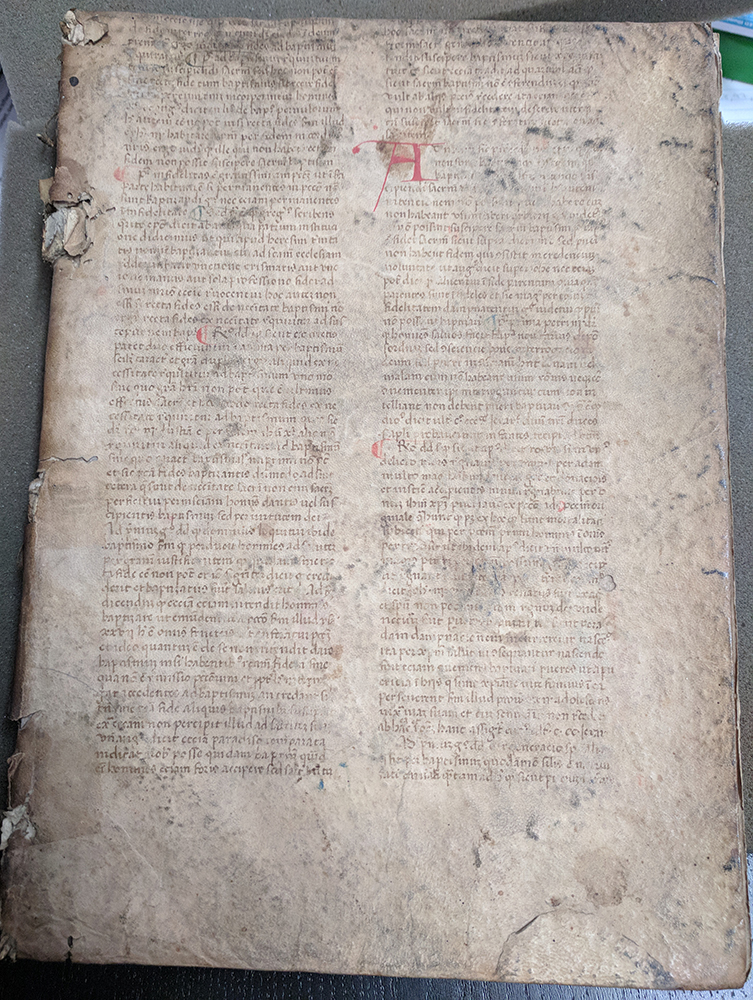The text on this binding is part of Thomas Aquinas’ Summa Theologiae. The front cover contains a section of the Third Part [Christ], Question 68 [Of Those Who Receive Baptism], Articles 8 [Whether faith is required on the part of the one baptized] and 9 [Whether children should be baptized]. The back cover contains a section of the Third Part [Christ], Question 72 [Of The Sacrament of Confirmation], Articles 4 [Whether the proper form of this sacrament is: “I sign thee with the sign of the cross,” etc.] and 5 [Whether the sacrament of Confirmation imprints a character].
The script seems, at first glance, to resemble a Caroline miniscule, but it also has features of Gothic scripts. Caroline miniscule evolved into Gothic scripts during the late 11th and early 12th centuries. The r’s curve down towards to proceeding letter but do not touch; there is no biting of bows; spacing between letters and words is clear; rounded letters are not angular or compressed: these are Caroline features. The feet of the minims of m’s and n’s go towards the left, rather than the right or straight down; ascenders are tall and straight: these are Gothic features.
However, by circa 1225, scribes generally tended to write in Gothic scripts. Aquinas did not complete Summa until 1274, nearly 50 years after the shift in script. During the late 14th or early 15th centuries, northern Italian scribes began looking back to the Caroline script for their works – perhaps Gothic scripts were too hard on the eyes, or perhaps they were influenced by the Humanistic movement, which revitalized interest in classical Greek and Latin texts.
The Italian humanistic script was commonly used for Humanistic texts, of which Aquinas’ Summa was included.
Based on the contents of the manuscript, the script, and the publisher for each of the two works bound in this volume, I place the wrapper to early 15th century, northern Italy.
The book: Offredus, Apollinaris. Apolinaris expositio in primum posteriorum Aristotelis cum questionibus eiusdem. Impresse vero Uenetijs : Arte Boneti de Locatellis Bergomensis, impensa nobilis viri D[omi]ni Octauiani Socti, ciuis Modoetiensis, anno salutis nostre 1493 14 Kalendas Apriles [19 March]. Bound with Bianchelli, Mengo. Incipit tractatus de primo [et] vlti[m]o insta[n]ti excellentissimi artiu[m] et medicine doctoris magistri Menghi Blanchelli Fauentini ad fratrem carolum fauentinu[m] ordinis seruorum. [Ferrara : Laurentius de Rubeis, de Valentia, and Andreas de Grassis, de Castronovo, 7 Sept. 1492]
Sources:
Aquinas, St. Thomas. Summa Theologiae, trans. by Fathers of the English Dominican Province. Benziger Bros. edition, 1947. Web version courtesy of Sandra K. Perry.
Brown, Michelle P. and Jane Winters, Project Co-Directors. Inscribe Paleography. School of Advanced Study, University of London. 31 January 2013.
Cappelli, Adriano. The elements of abbreviation in medieval Latin paleography, trans. David Heimann and Richard Kay. Lawrence, Kansas: University of Kansas Libraries, 1982.
Clemens, Raymond, and Graham, Timothy. Introduction to Manuscript Studies. Ithaca, New York: Cornell University Press, 2007.
Tillerson, Diane. Medieval Writing: History, heritage, and data source. 20 February 2016.

